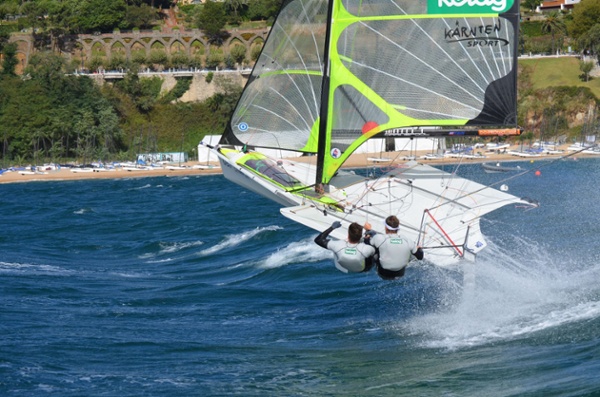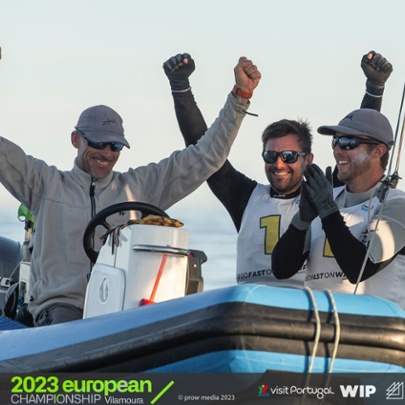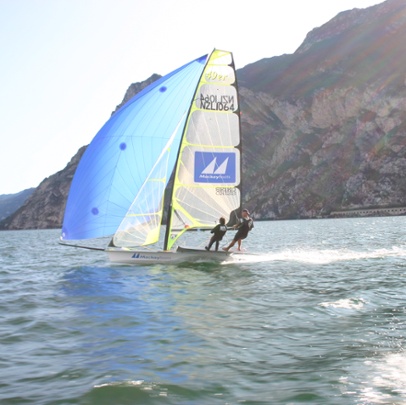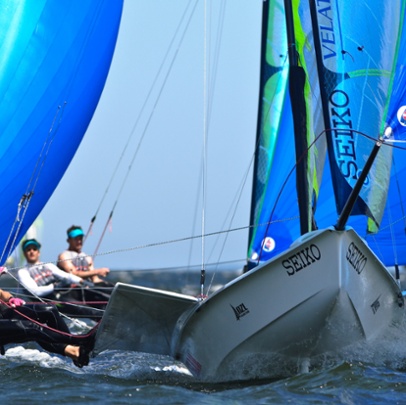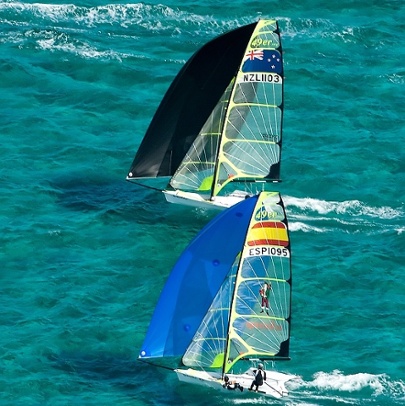The 49er
Adrenaline pumping speed. The skiff that flies.
It's one of the most powerful experiences in high performance, double handed skiff sailing. Using a twin trapeze, self-tacking jib, asymmetric gennaker and solid wings, the Mackay built 49er reaches speeds of 25 knots. It's also the boat used by Olympic winning and World Champion teams.
- One
- Two
- Three
Find out more in the Features section below
Specifications
No of crew: 2
Opt. crew weight: 145 – 165 kg’s
No. Trapeze: Twin
Hull material: GRP
Hull length: 4.995m
Beam length: 2.9m
Hull weight: 94kg
Mainsail area: 16.1m2
Headsail area: 5.1m2
Spinnaker area: 21.2 m2
The 49er is the men's Olympic Skiff Class.
49er Class association website http://49er.org/
The Hull
The 49er is 16ft long and made of fiberglass and carbon fibre for optimum strength and lightweight. Weighing 125 kgs when fully rigged, its optimal length to weight ratio and very fine hull lines, help produce excellent lift in waves and maneuverability.
The Wings
The boat features distinctive wings 9ft wide to allow the crew to achieve maximum leverage and to support the rig. The wings are designed to blend into the hull and cockpit area which optimises aerodynamics and makes it easy to move around. The wings are fastened to the hull and can be easily detached.
The Rig
CST became the carbon fibre tube suppliers in 2021. All tubes are QA checked plus bend and weigh tested by CST to ensure consistency.
The mast is assembled by the class builders. All mast fittings are the same on the 49er and FX so spare parts can be used for either boat.
The spreaders are built from recycled carbon. The mast join system and spreader base was recently redesigned for added strength around the trapeze area.
The Sails
The huge sail area for such a small boat means that the 49er can sail faster than the speed of the wind.
New sails
The Class is moving to a new range of sails in 2022. The main and jib sails will be built by North Sails using the 3Di technology which is a 3D full sized molding construction process that uses composite materials. The technology enables sails to be built to the desired shape and retain shape over time. This change to the “black sails” will improve the longevity and consistency while also decreasing the overall cost of sails.
The spinnaker has also undergone design changes and will be built by McDiarmid Sails.
The new sails are currently under development and due to be available in early 2022.
The boat package comes complete with all ropes and sheets from Robline, rudderstock, 2 x tiller extensions, gennaker pole, boom and turnbuckle set.
The Rig package comes complete with mast, wires, halyards, halyard adjusters, trapeze lines and trapeze adjusters.
***Boatbreaker and footstraps are not included and need to be ordered as extra items.
The concept of the 49er is that all boats are the same. We offer the option to upgrade to EVA foam for non-skid on the wings and also offer a service to custom pack and align the centrecase.
Sail numbers and flag details can be found on the class website: 49er Class Association
The class rules clearly state what can be added and changed on the boat as part of maintenance. Blocks and ropes can be replaced with similar products by other manufacturers. Please read the rules carefully and remember, you cannot change anything unless the rule specifically allow it.
Wings must be transported with the foam blocks under each wing to stop the underside denting on the wing plinths on the deck. Make sure they are tied down well so they don’t fly away!
Place padding under the ties in the non-skid areas to protect your non-skid and stop it wearing.
Small gel coat repairs are relatively easy to do.
What is Gelcoat made up of?
Gelcoat is a polyester product that is cured by using a catalyst called MEKP. (Methyl Ethyl Ketone Peroxide)
MEKP is a dangerous substance and should be treated as such when using, being very careful not to get any on your skin or in your eyes.
How can I get the catalyst - MERK?
We cannot ship MEKP so you will always need to buy it separately from your local marine store or fibreglass manufacturer.
How much MERK do I need?
The amount of Catalyst varies depending on the conditions you are using it in, but around 2%-3% will always work.
It is best to use a small syringe or dropper to get the required catalyst rate.
If you have mixed 100gm of gelcoat, then you are aiming for 2ml of catalyst.
Generally, polyester doesn’t stick well to Epoxy, so if you are repairing an epoxy boat, then you should source a special epoxy compatible gelcoat.
What are the Gelcoat colours?
Gelcoats colours are not always a 100% perfect match.
Colour will vary depending on the depth of the repair and the batch.
49er, VX One & Zephyr are built from Epoxy resin.
For the epoxy boats we use a product made by Scot Bader.
Grey is Crystic 253 RAL= 7035
White is Crystic 253 PA - White 337
Does Mackay Boats supply gelcoat?
We supply a small tin (of each relevant colour) with each new boat.
Order additional gelcoat from our store, although it cannot be shipped by courier.
How do I do gelcoat repairs?
Doing gelcoat repairs is an art that improves with experience.
Making sure the surface is prepared well and keyed up is critical.
Overfill and then sanding back is a slow and time-consuming process.
Be very careful not to scratch the boat around the repair.
You shouldn’t sand the original surface around the repair with any paper coarser than 600grit.
Mask around the repair to protect the boat.
You can initially use a file or 150g to take the high parts off the filling, but don't use the coarse paper for too long or you will end up with scratches in the finished repair.
Once you have it fair with 600g, you can work your way through the sandpaper grades until you finish with 1500grit before cutting and polishing.
We would typically use 600g, then 800g or 1000g, then 1200g, then finally 1500g.

